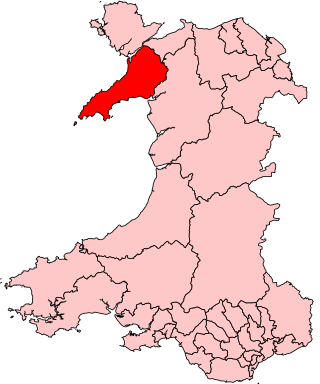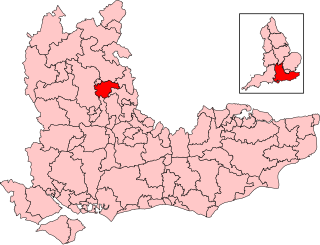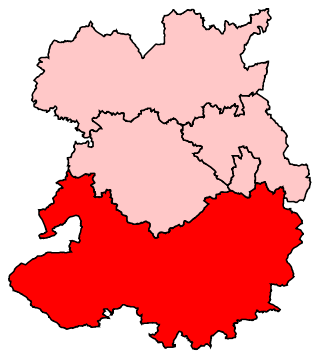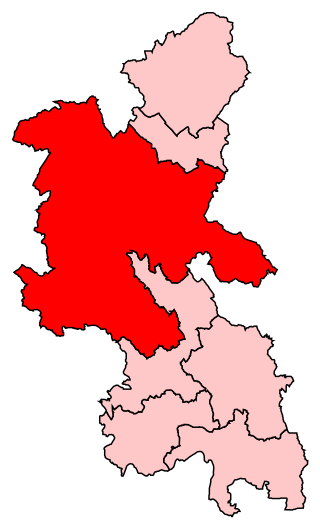Over the history of the House of Commons, the number of Members of Parliament (MPs) has varied for assorted reasons, with increases in recent years due to increases in the population of the United Kingdom. There are currently 650 constituencies, each sending one MP to the House of Commons, corresponding to approximately one for every 92,000 people, or one for every 68,000 parliamentary electors.

Monmouth was a county constituency of the House of Commons of the Parliament of the United Kingdom. The seat was created for the 1918 general election. From 2005 until 2024 the Member of Parliament (MP) was David Davies of the Conservative Party.

Caernarfon was a parliamentary constituency centred on the town of Caernarfon in Wales. It elected one Member of Parliament (MP).

Wycombe is a constituency in Buckinghamshire represented in the House of Commons of the UK Parliament since 2024 by Labour's Emma Reynolds.

Ludlow was a constituency in Shropshire represented in the House of Commons of the UK Parliament.

Huntingdon is a constituency west of Cambridge in Cambridgeshire and including its namesake town of Huntingdon. It has been represented in the House of Commons of the UK Parliament since 2024 by Ben Obese-Jecty of the Conservative Party.

Buckingham was a constituency that was last represented in the House of Commons of the UK Parliament by Greg Smith, a Conservative.
Newport was a borough constituency in Monmouthshire from 1918 to 1983. It returned one Member of Parliament (MP) to the House of Commons of the Parliament of the United Kingdom, elected by the first past the post system.

Chippenham is a constituency represented in the House of Commons of the Parliament of the United Kingdom since 2024 by Sarah Gibson, a Liberal Democrat. The 2024 constituency includes the Wiltshire towns of Calne, Chippenham, Corsham and Royal Wootton Bassett.

Maldon is a constituency in Essex represented in the House of Commons of the UK Parliament since its recreation in 2010 by Sir John Whittingdale, a Conservative.
Cambridgeshire is a former Parliamentary constituency in the United Kingdom. It was a constituency represented by two Members of Parliament in the House of Commons of the Parliament of England then in the Parliament of Great Britain from 1707 to 1800 and in the Parliament of the United Kingdom from 1801 to 1832, when its representation was increased to three until it was abolished in 1885.

Abingdon was a parliamentary constituency in England, represented in the House of Commons of the Parliament of England until 1707, then of the Parliament of Great Britain from 1707 to 1800 and of the Parliament of the United Kingdom from 1801 to 1885. It elected one Member of Parliament (MP) from 1558 until 1983, making it one of the few English constituencies in the unreformed House of Commons to elect only one Member of Parliament (MP) by the first past the post system of election.

Shrewsbury is a parliamentary constituency in England, centred on the town of Shrewsbury in Shropshire. It has been represented in the House of Commons of the Parliament of the United Kingdom since 2024 by Julia Buckley.

Newton was a parliamentary borough in the county of Lancashire, in England. It was represented by two Members of Parliament in the House of Commons of the Parliament of England from 1559 to 1706 then of the Parliament of Great Britain from 1707 to 1800 and of the Parliament of the United Kingdom from 1801 until its abolition in 1832.
Woodstock, sometimes called New Woodstock, was a parliamentary constituency in the United Kingdom named after the town of Woodstock in the county of Oxfordshire.
The Parliamentary representation by historic counties is summarised in this article, with links to the articles about the representation of each of the historic counties in the House of Commons of the Parliaments of England, Great Britain (1707-1800) and the United Kingdom.
Monmouth Boroughs was a parliamentary constituency consisting of several towns in Monmouthshire. It returned one Member of Parliament (MP) to the House of Commons of the Parliaments of England, Great Britain, and finally the United Kingdom; until 1832 the constituency was known simply as Monmouth, though it included other "contributory boroughs".

Monmouthshire is a constituency of the House of Commons in the UK Parliament, and was first contested at the 2024 general election, following the 2023 Periodic Review of Westminster constituencies. Its current MP is Catherine Fookes, a member of the Labour.
Denbigh District of Boroughs was a parliamentary constituency centred on the town of Denbigh in Wales. It returned one Member of Parliament (MP) to the British House of Commons.
This page is based on this
Wikipedia article Text is available under the
CC BY-SA 4.0 license; additional terms may apply.
Images, videos and audio are available under their respective licenses.











